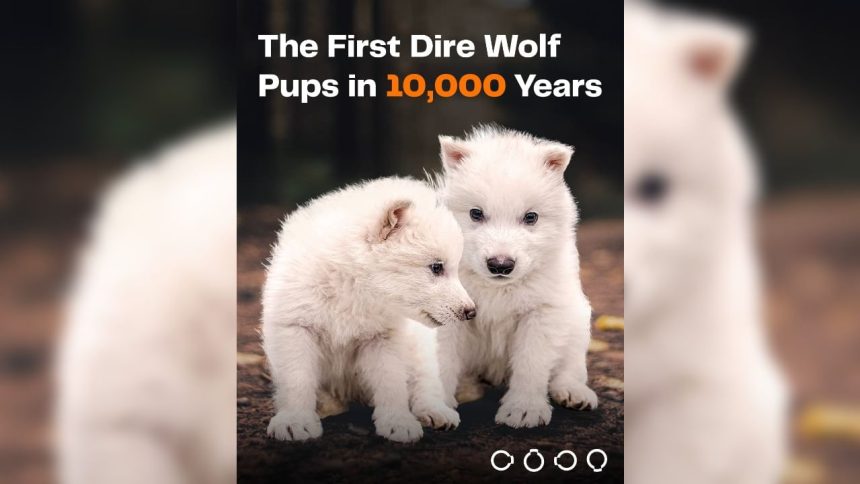It is a development that has effectively blurred the line between science fiction and reality. Researchers have achieved what was once thought impossible: bringing an extinct animal back to life. The dire wolf is now back, after 13,000 years of extinction.
Three pups — Romulus, Remus, and Khaleesi — have become the first living examples of de-extinct animals. They are not mythic creatures drawn from fantasy lore like Game of Thrones, but lab-grown realities rooted in one of the planet’s most formidable prehistoric predators. The dire wolf, Aenocyon dirus, vanished from Earth around 10,000 years ago at the end of the last Ice Age. And now, the fabled Ice Age predator walks among us again, thanks to the advances in synthetic biology and ancient DNA reconstruction.
‘World’s first successfully de-extincted animal’
Colossal Biosciences has claimed that the dire wolf is the “world’s first successfully de-extincted animal”. This Dallas-based biotech company has claimed credit for reviving the dire wolf by unveiling the three genetically engineered pups with signature traits of Aenocyon dirus.
Colossal Biosciences shared the spectacular and awe-inspiring video on social media, with the caption: “SOUND ON. You’re hearing the first howl of a dire wolf in over 10,000 years. Meet Romulus and Remus—the world’s first de-extinct animals, born on October 1, 2024.”
SOUND ON. You’re hearing the first howl of a dire wolf in over 10,000 years. Meet Romulus and Remus—the world’s first de-extinct animals, born on October 1, 2024.
The dire wolf has been extinct for over 10,000 years. These two wolves were brought back from extinction using… pic.twitter.com/wY4rdOVFRH
— Colossal Biosciences® (@colossal) April 7, 2025
They achieved this groundbreaking feat by using ancient DNA, cloning and gene-editing technology to alter the genes of the grey wolf — the dire wolf’s closest living relative — to create a hybrid species that bears a striking semblance in appearance to its extinct ancestor.
Drawing the distinction between the grey wolf and the dire wolf, the scientists at Colossal were reported to saying that the dire wolves were larger in size than gray wolves and “had a slightly wider head, light thick fur and stronger jaw”.
And it is not just the dire wolves that will see the light of the 21st Century. Colossal has also been working on resurrecting the mammoth, dodo, and Tasmanian tiger since 2021. However, the company has been keeping the work on reviving the dire wolves under wraps.
The ecological domino effect
However, it is not all good news. The return of an apex predator like the dire wolf raises a volley of questions about ecosystem balance. To begin with, plenty could go wrong with de-extincting species like the dire wolf. Ecological chaos, ethical dilemmas and unforeseen consequences are just the tip of the iceberg.
Imagine the kind of bedlam that reintroducing a species gone for 10,000 years could unleash. Game of Thrones offers a glimpse into the potential turmoil that comes as a risk with disrupting modern ecosystems. Cool tech, sure, but nature is not a sci-fi playground, no?
The implications of de-extinction are complex
Will these apex predators fit into a world vastly different from the one they left behind? How will these apex carnivores fit into a world vastly different from the one they left behind? Will they be able to coexist with the species currently inhabiting the planet, or will their presence disrupt fragile habitats that are already stressed by climate change and human encroachment?
After all, the dire wolf wasn’t just any wolf. It was larger, stronger, and hunted in packs. It played a critical role in Ice Age food webs, preying on megafauna that no longer exist today. In a modern landscape of deer, livestock, and diminishing forests, what will be their role now? It’s not just about whether they survive—it’s about what happens to everything around them.
Ethics and evolution
Beyond the ecological debates lies a more ethical dilemma: Should we be resurrecting extinct animals at all?
Those in favour of de-extinction could argue that bringing back lost species can help repair damaged ecosystems and inspire environmental consciousness. However, the naysayers would warn against “playing god” and the unknown consequences of releasing genetically reconstructed species into the wild.
There’s also the issue of authenticity. Are Romulus, Remus, and Khaleesi true dire wolves? Or are they genetic hybrids shaped by scientific necessity? Their DNA is reconstructed from fragments, supplemented by grey wolf sequences. The result is not a perfect clone, but a close approximation. But will it be enough to revive the spirit and function of the original?
And before we delve deeper into the ethics debate, maverick businessman Elon Musk has already requested Colossal for a “miniature pet wooly mammoth”.
Please make a miniature pet wooly mammoth https://t.co/UxoIWmzq6h— Elon Musk (@elonmusk) April 7, 2025
The beginning of a chapter or the beginning of the end?
As the dire wolf pups grow, they will be monitored for behaviour, health, and adaptability. If successful, the team plans to gradually introduce more dire wolves, possibly into controlled, semi-wild habitats. For now, Romulus, Remus, and Khaleesi live under strict supervision in a high-security research facility.
Their arrival signals not just a scientific breakthrough, but a turning point in humanity’s relationship with nature. Will we use this power to repair what we’ve broken? Or will it further complicate the delicate web of life? What is certain, however, is that the howl of the dire wolf may soon echo once again. And it will not be in ancient forests of the past, but in the brave, uncertain world of tomorrow.




